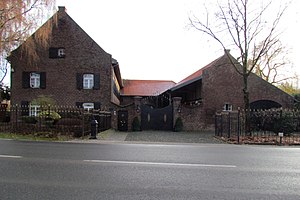Full mill interruption
| Full mill interruption
|
||
|---|---|---|
|
The full mill interruption |
||
| Location and history | ||
|
|
||
| Coordinates | 51 ° 4 '16 " N , 6 ° 6' 47" E | |
| Location | Germany | |
| Waters | worm | |
| Built | 1419 | |
| Shut down | 1983 | |
| Status | listed property | |
| technology | ||
| use | Fulling mill , grain, oil, bone and tan mill | |
| Grinder | a grinder , an oil press | |
| drive | a water wheel | |
| water wheel | undershot | |
The Vollmühle Unterbruch was a water mill with an undershot water wheel on the Alte Bach der Wurm , in the town of Heinsberg in the North Rhine-Westphalian district of Heinsberg in the administrative district of Cologne .
geography
The full mill interruption had its location on the left side at Old Bach of the worm at the Wassenberger Straße 1, in the district of interruption in the town of Heinsberg. The property on which the mill building stands is approx. 37 m above sea level . With the worm regulation in the 1960s, the new Wurm river bed was created about 30 m from the mill. Before that, it was the Alte Bach der Wurm, an artificial branch from the Wurm, which supplied the mill with water.
Waters
The worm supplied numerous mills with water over a river length of 53 km. The source of the worm is south of Aachen at 265 m above sea level. The confluence with the Rur is in the town of Kempen in the town of Heinsberg at 32 m above sea level. In the late 1960s and early 1970s, worm straightening was carried out. The curving, now and then meandering course of the river disappeared in favor of a simple route . The river length shortened and the flow speed increased. For many people the flood protection improved , for the mills it was the end. The water association Eifel-Rur (WVER) is responsible for the care and maintenance of the water body with a catchment area of 355.518 km 2 .
history
The first documented history of the Vollmühle interruption relates to the year 1419. In that year Johann II von Leon, Herr zu Heinsberg , and his wife Margaretha von Gennep sold Gerhard von der Huet a grain rent of 100 Malter rye for 1400 guilders , 40 of which came from the lease of the Vollmühle. The use of the mill was very diverse. In the course of its history it was used as a fulling mill , grain, oil, bone and tan mill as well as for chopping. For the places Unter- and Oberbruch there was at times a mill obligation . In the 17th century the village of Unterbruch was the operator of the mill , in the French times the town of Heinsberg . The current buildings were erected in 1827. With the worm regulation in the 1960s, the water wheel of the full mill also disappeared from the scene. Until 1983, the mill continued to operate with an electric drive in the listed mill .
gallery
The Vollmühle interruption on the tranchot card 1805/1807
Monument entry
Vollmühle from 1828 (anchor pins on the house), three-winged brick courtyard, two-storey house on the gable in two to seven axes
Way cross in front of the building from the middle of the 19th century, stone base, cross and body, cast iron, entry in the list of monuments on July 8, 1985
literature
- Hans Vogt: Lower Rhine water mill guide 2nd edition. Verein Niederrhein, Krefeld 1998, ISBN 3-00-002906-0 , pages 294-295.
- Hubert Berens: The mills of the city of Heinsberg home calendar of the district of Heinsberg 1985, page 23-35
- H. Tichelbäcker: The Heinsberger Mühlenkanal home calendar of the Selfkantkreis Geilenkirchen-Heinsberg 1962, page 128-135 and 1963, page 142-144
→ See also the list of mills on the Wurm
Web links
Individual evidence
- ^ German basic map 1: 5000
- ↑ Topographical Information Management, Cologne District Government, Department GEObasis NRW ( Notes )
- ↑ Archived copy ( memento of the original from October 17, 2013 in the Internet Archive ) Info: The archive link was inserted automatically and has not yet been checked. Please check the original and archive link according to the instructions and then remove this notice.
- ↑ http://www.wver.de/







